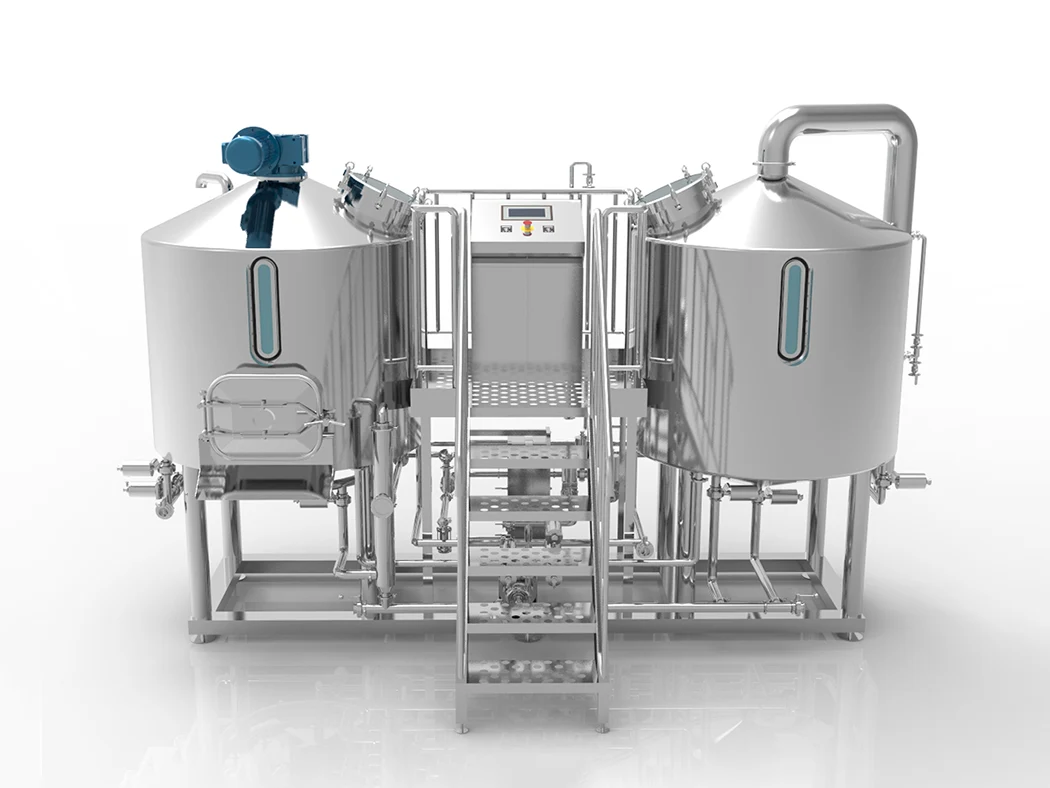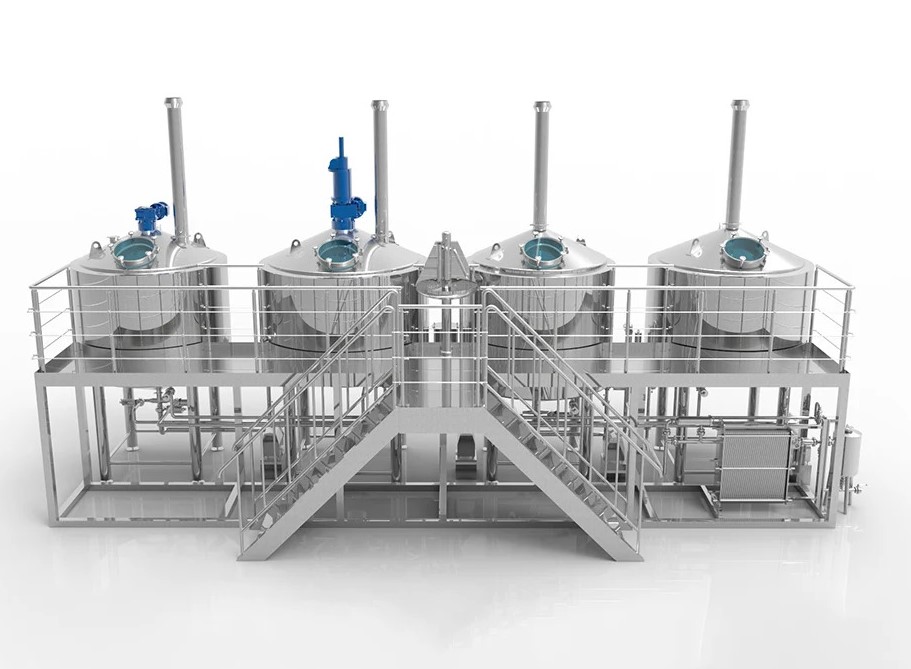自分の醸造所を立ち上げることを夢見ているが、設備の選択肢に圧倒されている?間違ったセットアップを選択すると、資本を浪費し、高品質のビール生産を妨げます。醸造設備製造プラントの専門家として、私たちはあなたの成功のために完璧な商業醸造設備を選択することをご案内します。
業務用クラフトビール醸造設備とは、醸造所が販売用のビールを製造するために使用する特殊な機械やタンクを指します。これには、穀物粉砕機やブリューハウス(マッシュタン、ケトル、ワールプール)から、発酵タンク、ブライトタンク、冷却機、ポンプ、包装ラインまで、あらゆるものが含まれます。効率的な生産、安定した品質のビール、そしてクラフトビール醸造所の全体的な成功のためには、高品質で耐久性があり、適切なサイズの業務用醸造機器を選択することが極めて重要です。
業務用醸造設備とは何か?
について話すとき 業務用醸造設備ここでいう堅牢で大規模なシステムとは、以下のようなものを指す。 ビール 小規模な自作セットアップではなく、販売を目的としたものである。これは ビール 原材料から完成品まで、お客様にお届けするまでの創造。単なる ケトル そして 発酵槽それは、効率性、一貫性、量のために構築された一貫したシステムである。
として メーカー このようなシステムを構築してきた長年の経験により、私たちはどのようなシステムであっても、その心臓部は、そのようなシステムであることを知っています。 醸造所 にある。 醸造所.通常、マッシュタン、ローターチューン、ブリューチューンなどの容器を使用します。 ケトルそしてジャグジー。その横には 醸造所必要不可欠なサポート 備品・消耗品ホット・リカーやコールド・リカー・タンクなど、 パンプス熱交換器(チラー)、そして洗練された 温度管理 システムである。趣味のセットアップとプロのセットアップを区別するのは、これらのコンポーネントの統合と品質である。 業務用醸造設備.
その範囲は、発酵やコンディショニングの段階にも及び、専用の設備が必要となる。 発酵 タンク 円錐形 発酵器 酵母処理用)、炭酸と清澄のためのブライトタンクがある。最後に パッケージング 機器 ケグが完成する。 コマーシャル セットアップ各パーツは 醸造工程を確保する。 醸造家 確実に生産できる 高品質 ビール.
なぜ高品質のステンレス鋼が業界標準なのか?
の輝き。 ステンレス鋼 それは単なる見せかけではなく、優れた製品を生み出すための基本なのだ。 ビール.主に、 ステンレス鋼 特に 304ステンレス またはそれ以上のグレード)は、腐食や錆に驚くほど強い。これは 醸造所 機器が常に湿気や酸性の麦汁にさらされる環境、 ビールそして洗浄剤。長寿命と 信頼性 あなたの投資の
さらに ステンレス鋼 は無孔質で表面が滑らかです。このため、洗浄と消毒が非常に簡単で、醸造において最も重要なのは、微生物汚染を防ぐことである。 バッチ の ビール.プラスチックや木材のような素材とは異なり、雑菌や異臭を寄せ付けないため、純粋さと意図した味のプロファイルを保証します。 クラフトビール.マッシュから チューン 最後の盛り付けまで タンク, ステンレス醸造 設備は最高水準の衛生状態を維持するのに役立つ。
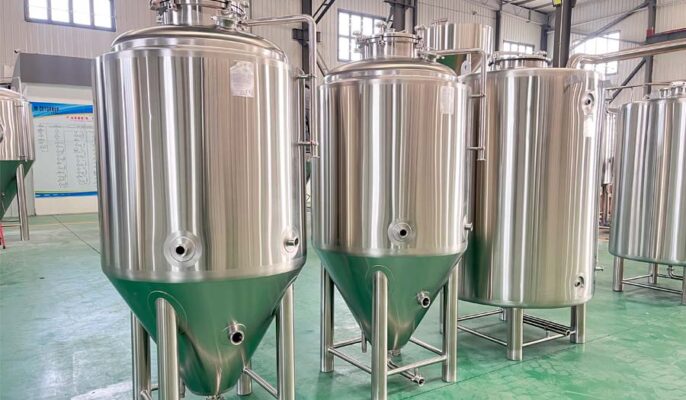
製造業者および施工業者として、私たちは以下のものを独占的に使用しています。 高品質 ステンレス鋼 というのも、それはまた 温度管理 特性があります。加熱や冷却のためのジャケットを簡単に取り付けることができ、マッシング中や冷却中の温度を正確に管理することができる。 発酵.の酵素活性にはこの制御が不可欠である。 マッシュ そして イースト 健康 発酵最終的な結果には直接影響する。 上質なビール.それは、信頼できるプロフェッショナルのための基幹素材である。 醸造設備.
業務用醸造所の主な構成要素とは?
について 醸造所 は、穀物、水、ホップを麦汁に変える魔法が本当に起こる場所だ。麦汁のエンジンルームなのだ。 醸造所.構成は様々だが(2ベッセル、3ベッセル、4ベッセルなど)、核となる機能は変わらない。主なコンポーネントは以下の通り:
-
マッシュ・タン この容器で粉砕される 穀物 を熱水と混ぜる(マッシングと呼ばれる工程)。その目的は、澱粉に含まれる酵素を活性化させることである。 穀物 を発酵可能な糖に変える。最近のマッシュタンは、多くの場合、正確な発酵のための機能を備えている。 温度管理 そしてミキシング。
-
ラウター・タン マッシングの後、甘い液体(麦汁)を使用済み穀物から分離する必要がある。ラウター チューン 通常、麦汁を排出するための底やスクリーンがあり、穀物の殻を抑えている。スパージング(穀物をお湯ですすぐこと)もここで行われ、残った糖分を抽出する。マッシュタンとロータータンを1つの「マッシュ/ロータータン」に統合するシステムもある。
-
ブリューケトル 集められた麦汁は ケトル 沸騰させる。煮沸は麦汁を殺菌し、ホップのアルファ酸を異性化し(苦味を生み出す)、余分な水分を蒸発させ、タンパク質を凝固させる(ホットブレーク)。 ビール.ホップは通常、煮沸中の様々な段階で加えられる。多くの場合 醸造所 に内蔵されている。 ケトル 煮沸後、ホップのカスやタンパク質の固形物を分離させるために、別の容器として使用することもできる。
-
サポートする要素: 必要不可欠な付属品 パンプス 高温の液体や固体を扱うために設計された熱交換器(チラー)で急速に クール 熱い麦汁を 発酵温度 に行く前に 発酵槽および配管/バルブ(付属品)がすべてをシームレスにつないでいる。
コンパクトなシステムを検討している場合でも、大型のマルチベッセルセットアップを検討している場合でも、これらのコアコンポーネントを理解することは極めて重要である。
発酵タンクとブライトタンクの違いは?
両者とも 発酵 タンク発酵器そして ブライト タンクはボイル後のオペレーションに極めて重要であり、最終的なボイルの仕上がりを左右する重要な役割を担っている。 ビール.主な違いは、その機能とデザインの特徴にある。
発酵タンク は、冷却された麦汁が イースト.ここが主戦場となる。 発酵 酵母は、醗酵で生じた糖分を消費する。 醸造所 アルコールとCO2を生産する。主な特徴は以下の通り:
-
円錐形のボトム: イースト菌の沈殿物の回収と除去を容易にする。 発酵.
-
温度調節ジャケット: 最適な状態を維持するために重要なこと 発酵温度 特定の イースト を大きく左右する。 ビールの 風味の特徴。多くの場合 チラー システムである。
-
圧力リリーフバルブとサンプルポート: 安全性とモニタリングのために 熟成.
-
CIP(Clean-In-Place)システム: 効率的な衛生管理のために。
ブライトタンク (コンディショニングタンクやサービングタンクとも呼ばれる)は、一次タンクの後に登場する。 発酵.彼らの主な役割は以下の通りだ:
-
成熟とコンディショニング: を許可する。 ビール 熟成させ、透明化させ、風味を融合させる。
-
炭酸: Briteタンクは、炭酸化用に特別に設計された耐圧容器である。 ビール を希望のレベルに設定する。
-
明確になった: 残留イーストや微粒子の沈殿がさらに起こる可能性がある。
-
パッケージ: ビール から直接パッケージされることが多い。 ブライトタンク に ケグ に譲渡された。 パッケージング 瓶詰め/缶詰用のライン。
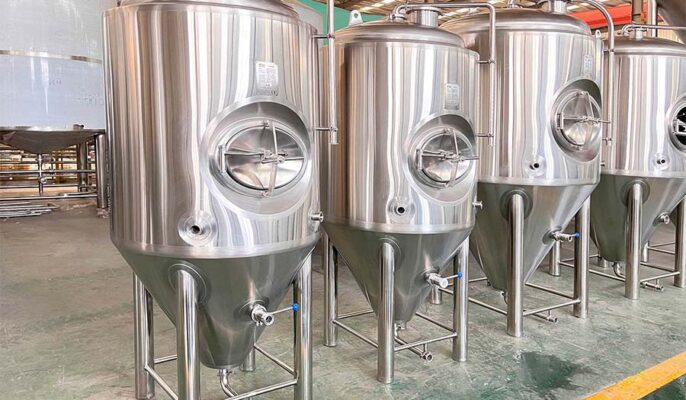
基本的には 発酵槽 は生物学的変化に対するものである。 ブライトタンク は、仕上げ、炭酸、準備のためのものである。 ビール 盛り付け用 パッケージング.私たちは、幅広い製品を製造しています。 ステンレス発酵タンク&ブライトタンク 様々な 醸造所 規模とニーズ
商業醸造所に不可欠なサポート機器とは?
コアを超えて 醸造所 および発酵/ブライト・タンク、いくつかのサポート・ピース 備品・消耗品 を円滑かつ効率的に行うために不可欠である。 商業醸造 オペレーションを怠ると、ボトルネックとなり、品質が損なわれる。これらをおろそかにすると、ボトルネックが生じ、品質が損なわれる。
-
穀物の取り扱い: そのためには、まず信頼できる 穀物ミル.穀物を適切に砕くことは、砂糖の効率的な抽出に不可欠である。 マッシュ.粉砕機の種類(例えば、2ローラー4本ローラー)は、規模や希望する粉砕の均一性による。粉砕された粉粒体の運搬には、オーガーやコンベヤーが必要な場合もある。 穀物 に対する マッシュタン より大きなシステムで
-
チラー/グリコール・システム 沸騰後の麦汁を急速に冷却し(熱交換器を介して)、正確な冷却を維持する。 発酵温度制御 は譲れない。適切なサイズのグリコール チラー の両方に必要な冷却能力を提供する。 醸造所 チラー ジャケットは 発酵器 そして ブライトタンク.
-
パンプス: 醸造所には様々な衛生設備が必要である。 パンプス 熱い麦汁の移送、麦汁の移動など、さまざまな作業用に設計されている。 ビール タンク間、洗浄液の循環(CIP)、そして可能性として パッケージング ライン正しい選択 ポンプ の種類とサイズは、効率と製品の完全性にとって極めて重要である。
-
清掃と衛生: クリーンインプレイス(CIP)システム(多くの場合、タンク付きのポータブルカート ポンプおよびヒーター)は、タンクやパイプを効率的に洗浄するために不可欠である。さらに ケグワッシャー のパッケージングに欠かせない。 ケグ再充填の前に、洗浄と消毒を徹底すること。
-
ユーティリティ 信頼性の高い給湯(ホットリキュールタンク)、冷水供給(コールドリキュールタンク)、蒸気(蒸気加熱用 醸造所)、圧縮空気、CO2はすべて必要なユーティリティである。
堅牢なサポート機器に投資することで 醸造工程 を円滑に実行し、その品質を守る。 業務用ビール.
醸造所の規模は設備の選択にどう影響するか?
あなたの規模 醸造所 経営に影響を与える最も大きな要因は、おそらく次のようなものだろう。 業務用醸造設備 選択肢小規模なビールパブに適したものと、地域生産者のニーズは大きく異なる。 醸造所.
小規模で多様なバッチに重点を置く新興企業や醸造パブには、300Lのユニットやフレキシブルなシステムのようなシステムが適しています。 500L 小ロット醸造システム は、適応性が高く、初期投資が少なくて済む。これらのシステムは手作業が多いが、実験や顧客への直接販売が可能である。生産需要が高まるにつれて、このようなシステムにステップアップすることも可能である。 10BBL 2 容器地ビール醸造装置 のセットアップは、管理可能なフットプリントを維持する可能性がありながら、より大きな容量を提供する。
より広範な流通を目指す大規模な事業では、かなり大規模で、多くの場合、より自動化されたシステムが必要となる。2000Lのような設備や、さらに大規模な 20HL 4容器商業醸造設備 が必要になる。これらのシステムは、より高いスループット、効率性、大量バッチでの一貫性を目指して設計されている。このようなシステムには、多くの場合、より高度な制御、より多くの 発酵器より大きい ブライトタンクそして献身的 パッケージング ライン。2本、3本、4本、あるいは5本から選べる。 醸造所 の複雑さによって異なる。 ビール スタイル、そして全体的な生産目標。
最終的な目標は 醸造設備 お客様の事業計画と予測される成長に合わせて、容量と自動化レベルをお選びいただけます。製造業者として、私たちは拡張可能なソリューションを提供します。 醸造所 不十分な設備に邪魔されることなく成長できる。 ビール醸造設備.
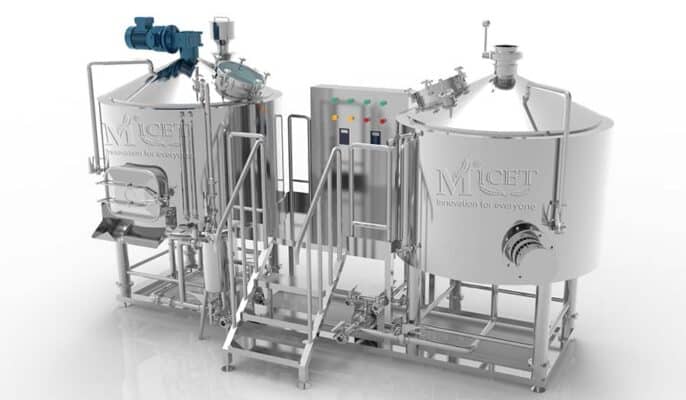
醸造所の設計において自動化を考慮すべきか?
自動化という問題は、現代社会の中心的な課題である。 醸造所デザイン.完全な手動システムも存在しますが、ある程度の自動化を取り入れることで、効率性、一貫性、さらには安全性を大幅に向上させることができます。 醸造所 体重計
基本的な自動化には単純なものが含まれる。 温度管理 グリコールの流量を自動的に調節し、設定値を維持する。 発酵器 またはマッシュ チューン.これにより 醸造家 絶え間ない手動調整から解放され、より一貫性のある調整が可能になる。 発酵 プロファイルとマッシュ温度 - 再現性を高めるために重要である。 上質なビール.より高度なシステムでは、バルブシーケンスを自動化することができます、 ポンプ 操作、ホップ添加のタイミング、醸造サイクル全体のデータロギングまで。
を導入する。 自動醸造システム にはいくつかの利点がある:
-
一貫性: 人為的なミスによるばらつきを減らし、各 バッチ 特定の ビール レシピの味は変わらない。
-
効率が良い: 反復作業を自動化することで、醸造家はレシピ開発、品質管理、セラー管理など、より重要な側面に集中することができる。また、醸造サイクルをより早くすることができ、人件費を削減できる可能性もある。
-
データロギング: 自動化システムは、多くの場合、重要なデータポイント(温度、時間、量)を記録し、トラブルシューティング、プロセスの最適化、品質保証のために非常に貴重である。
-
安全だ: CIPやホットリカー移送のようなプロセスを自動化することで、潜在的に危険な化学物質や高温の手作業を減らすことができる。
しかし、自動化には高い初期投資が必要であり、システムを操作・維持する技術的スキルを持ったスタッフが必要となる。最適な自動化レベルは、以下の項目によって決まる。 醸造所の 規模、予算、スタッフ、制作目標。私たちは、以下のようなクライアントと密接に協力しています。 業界初心者 への 経験豊富な醸造家適切な自動化レベルのシステムを設計すること。
業務用ビールのパッケージの選択肢は?
仕上がり クラフトビール より ブライトタンク 消費者の手に渡るには パッケージング 解決策主な選択肢 商業醸造所 樽詰め、缶詰、瓶詰である。
-
樽詰め: ビールパブやドラフト販売に力を入れている醸造所では、これが出発点になることが多い。そのためには ケグ (様々なサイズがあります)、1つの 樽 ウォッシャー/サニタイザー 樽 フィラー樽詰めは比較的簡単で、保存がきく。 ビール 特に地元での流通に適している。
-
缶詰: 缶詰は、その持ち運びやすさ、完全な遮光性(「スカンク」風味の防止)、そして環境面での利点から人気が急上昇している。缶詰ラインは、地ビール醸造所に適した小型の手動システムから、大量生産用の高速回転式充填機まで幅広い。缶詰は、溶存酸素レベルを維持するために細心の注意を払う必要がある。 ビール 安定性がある。
-
瓶詰め: 伝統的な選択肢であるボトリングラインも、サイズや自動化によって大きく異なる。ボトルは古典的な演出ができるが、重く、割れやすく、濃いガラスを使わない限り光によるダメージを受けやすい。缶詰と同様、充填中の酸素ピックアップを最小限に抑えることは、保存期間にとって重要である。
その選択は、ターゲットとする市場(ドラフトか小売か)、流通範囲、ブランドイメージ、予算による。多くの醸造所は、地元のバー向けに樽詰めを行い、小売販売向けに缶詰/瓶詰めを行うなど、組み合わせて利用している。信頼できる投資 包装設備 を提示することが重要である。 ビール プロフェッショナルとして、お客様に最適な状態でお届けすることをお約束します。
適切な機器メーカーやサプライヤーを見つけることがいかに重要か?
正しい選択 メーカー または サプライヤー あなたの 業務用醸造設備 というのは、自分の仕事に適した食材を選ぶのと同じくらい重要なことなのだ。 ビール.このパートナーシップは、最初の購入にとどまらず、次の購入にも影響を与えます。 デザイン の段階、設置、試運転、および長期的なサポートが含まれます。 醸造所.
評判の良い サプライヤー私たちと同じように、もっと コンサルタント とパートナー。私たちは以下の分野で長年の経験を持っています。 製造および設置 醸造システム あらゆる規模のそのため、私たちは、以下のような業務において、貴重な見識を提供することができる。 醸造所デザイン の段階で、レイアウト、ワークフロー、ユーティリティ要件の最適化を支援します。私たちは ステンレス鋼 製造、溶接基準、衛生管理 デザイン にとって重要である。 高品質の醸造設備.
探す メーカーとインストーラー を提供している:
-
カスタマイズ: テーラーメイド能力 醸造設備 あなたのスペース、予算、醸造スタイルに合わせて。
-
高品質の素材と仕上がり: 使用方法 高品質 304ステンレス またはそれ以上であること、衛生的な溶接方法を順守していること、そして全体的に 信頼性.
-
包括的なサポート: 設置、試運転、トレーニングの支援、設置後の技術サポートとスペアパーツの提供。
-
実績: 社内での経験とポジティブな推薦 醸造業.あなたのプロジェクトと同じような設置が成功したことを証明できますか?
-
ビジョンを理解する を目指す新興企業であろうとなかろうと、あなたの目標に耳を傾けてくれるパートナー。 クラフトビールに命を吹き込む または 醸造所 キャパシティの拡大
最も安価なオプションを選択すると、ダウンタイムや一貫性の欠如など、コスト高につながる可能性がある。 ビール 品質とフラストレーション経験豊富な メーカー ミセット・グループのような信頼性の高い企業への投資を保証します、 最高級 備品・消耗品 長期的な成功のためにこのような大きな投資をする際には、専門知識と継続的なサポートの価値を過小評価しないでください。
ビールを超えて:この装置は他の飲料にも使えるか?
もちろんだ!設計は ビール醸造 を念頭に置きながら、核となる原則と ステンレス鋼 で使用されている。 醸造所 は、他の発酵飲料の製造にも適応性が高い。この汎用性は、製品ラインの多様化を目指す起業家にとって大きな利点となる。
-
コンブチャ: について 発酵タンク で使用した。 ビール はコンブチャに最適です。正確な 温度管理 そのため、SCOBYの活動を効果的に管理することができます。専門的な コンブチャ発酵タンク この人気のためにデザインされた 飲料.
-
ワイン&シードル ステンレス製発酵槽 そして ブライトタンク は、クリーンでコントロールされた発酵とコンディショニングのための、現代のワイナリーやシードル醸造所の定番である。プレス機のような特殊な設備が必要な場合もあるが、中核となるタンクのインフラはよく似ている。
-
ハードセルツァー: 製造工程では、多くの場合、ベースとなる糖分を発酵させる。 発酵器その後、濾過と風味付けが行われる。 ブライトタンク.
-
蒸留: 蒸留には特殊なスチルが必要だが、ウォッシュを作る初期段階(穀物や糖分を発酵させる)には、蒸留機と非常によく似た装置が使用される。 醸造所 そして 発酵器.
-
その他の飲み物 ミキシング・タンクや一般的な設備 ステンレス鋼 船舶の用途は多岐にわたる。 飲料 原料の混合、貯蔵、加工に使用される。
高品質で衛生的な設備への投資を中核とする。 ステンレス鋼 タンクと 温度管理 システムは、単なる飲料の製造にとどまらず、様々な飲料を製造するための柔軟な基盤を提供する。 業務用ビール.この適応力は、ビジネスの成長にとって大きな財産となる。
よくある質問
業務用醸造機器の一般的な価格帯は?
システムの規模($5万円以下の小規模なパイロットシステムから数百万円の大規模な生産醸造所まで)、自動化のレベル、容器の数(2容器か5容器か)によってコストは大きく異なります。 醸造所)、ブランドの評判(トップブランド 対あまり知られていない メーカー)、新品を買うか検討するか 中古醸造設備.スタートアップの7-10 BBLシステムは、多くの場合、このクラスに分類される。
150k-コアで35万円台 醸造設備設置費用と建築費用を除く。
醸造所の設置にはどれくらいのスペースが必要ですか?
必要なスペースは 醸造所 サイズ、数、大きさ 発酵器 そして ブライトタンク, パッケージング ライン・フットプリント、原材料と完成品の保管庫、冷蔵倉庫(ウォークイン クールer)、付属スペース(オフィス、タップルーム、ラボ)がある。小さなナノ醸造所 大規模な生産施設では数万平方フィートが必要だが、1,000~1,500平方フィートが必要な場合もある。適切な 醸造所デザイン とレイアウトのプランニングが重要である。
ケトルの直火、蒸気、電気加熱の違いは何ですか?
直接射撃ケトル 小型のシステムでは、バーナーで直接加熱する方式が一般的だが、焦げ付く危険性があり、制御の精度も低い。スチーム加熱(スチームジャケットを使用) ケトル)は均一で効率的な暖房を提供し、ほとんどの機種に標準装備されている。 業務用醸造設備 ただし、蒸気ボイラーが必要。電気暖房 没入 エレメントまたは電気ジャケット)は、精密な制御が可能でボイラーを必要としないが、運転エネルギーコストが高く、大量の加熱には時間がかかる。
醸造コンサルタントは必要ですか?
厳密には必要ではないが、特に経験豊富な監督と仕事をする場合は、その必要性は高い。 機器サプライヤー デザインサポート、醸造 コンサルタント であれば、その価値は計り知れない。 業界初心者.レシピの策定、プロセスの最適化、規制への対応、品質管理などをサポートします。 セットアップが提供する技術的な専門知識を補完する。 醸造設備デザイナー とメーカー。
醸造設備の製造と設置にはどれくらいの時間がかかりますか?
リードタイムは メーカーの バックログ、システムの複雑さとサイズ、カスタマイズの必要性。製造には通常2ヶ月から6ヶ月かかります。設置にかかる時間は、設置場所の準備状況、機器の複雑さ、設置者の経験によって異なります。 メーカーとインストーラー大規模なプロジェクトでは数週間から数ヶ月に及ぶ可能性がある。
業務用醸造機器にはどのようなメンテナンスが必要ですか?
定期的なメンテナンスは、長寿命と性能を維持するために非常に重要です。これには、日常的な清掃と衛生管理(毎日/毎週)、以下の予防的メンテナンスが含まれます。 パンプス およびモーター(ガスケット交換、潤滑)、計器の較正 (温度管理 センサー、圧力計)、溶接部の検査、および 付属品の定期的なディープクリーニングまたは不動態化処理。 ステンレス鋼 タンク以下はその例である。 メーカーの 推奨されるメンテナンス・スケジュールが鍵となる。
醸造所投資における重要なポイント
-
質の問題: 投資 高品質, ステンレス鋼 業務用醸造設備 信頼できる メーカー は、安定したプレーを実現するために極めて重要である。 上質なビールまた、経営効率を高め、長期的な視野に立った経営が可能になる。 信頼性.
-
システム・コンポーネント: それぞれの核となる部分の機能を理解する: 穀物ミル, 醸造所 (マッシュ チューン, ケトルなど)、 発酵器, ブライトタンク, チラー, パンプスそして パッケージング システムである。
-
適切なサイズ: 選ぶ 醸造設備 現在の事業計画と現実的な成長予測に基づくキャパシティ。スケーラビリティが重要です。
-
サポートシステム: グリコール・チラーやCIPシステムなど、必要不可欠なサポート機器も見逃してはならない、 ケグワッシャーまた、適切なユーティリティ設備も備えている。
-
自動化の可能性: 一貫性と効率性のための自動化の利点を検討し、運用上のニーズや規模に対する投資のバランスをとる。
-
メーカー・パートナーシップ: 選択する サプライヤー 設計の専門知識、カスタマイズ、設置サポート、継続的なサービスを提供するパートナーとして機能します。この関係は、お客様の クラフトビールを生活に.
-
汎用性がある: 核となるのは ステンレス鋼 コンブチャ、サイダー、ワインなど、他の飲料にも応用可能で、将来的な柔軟性を提供する。

